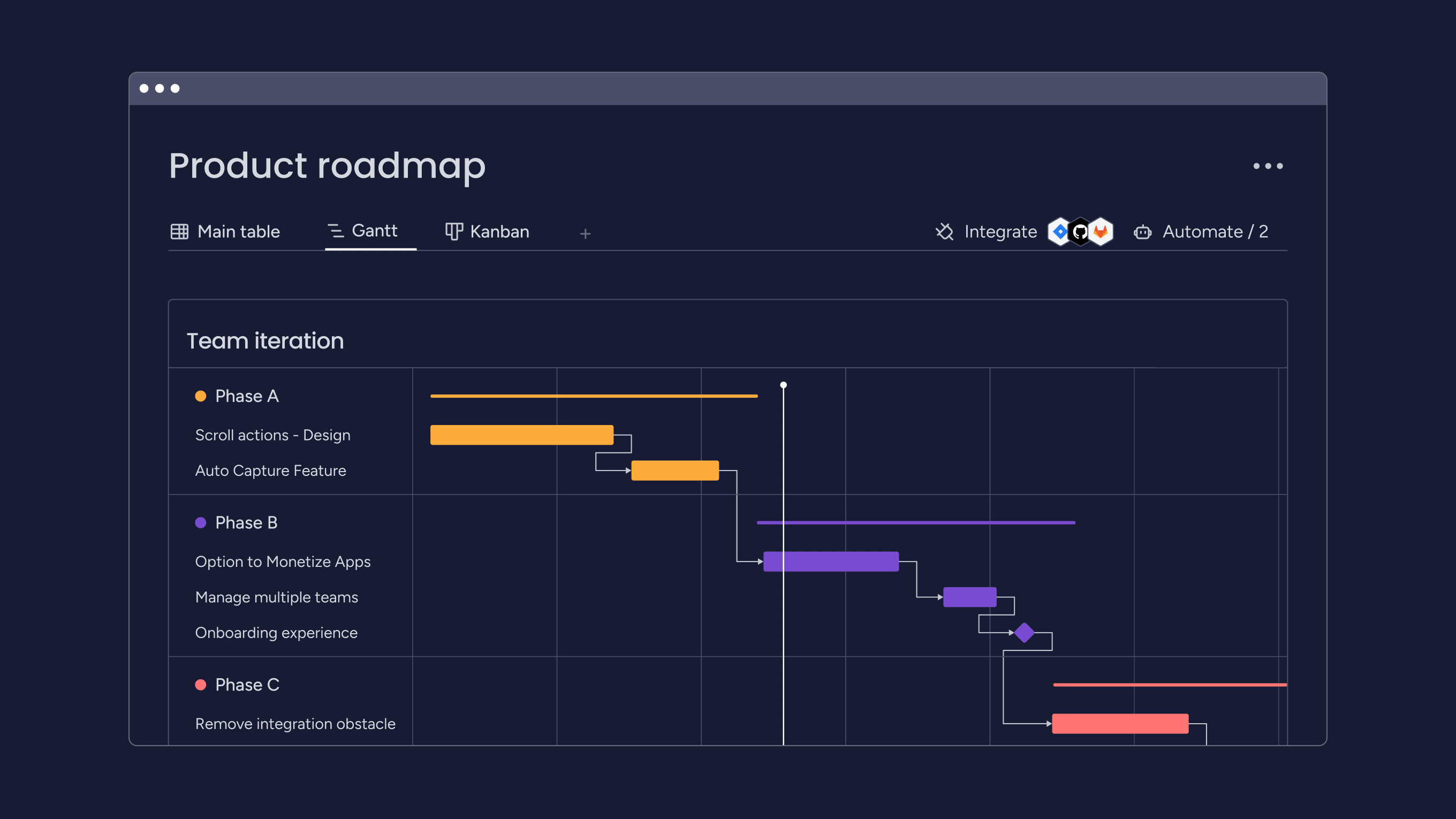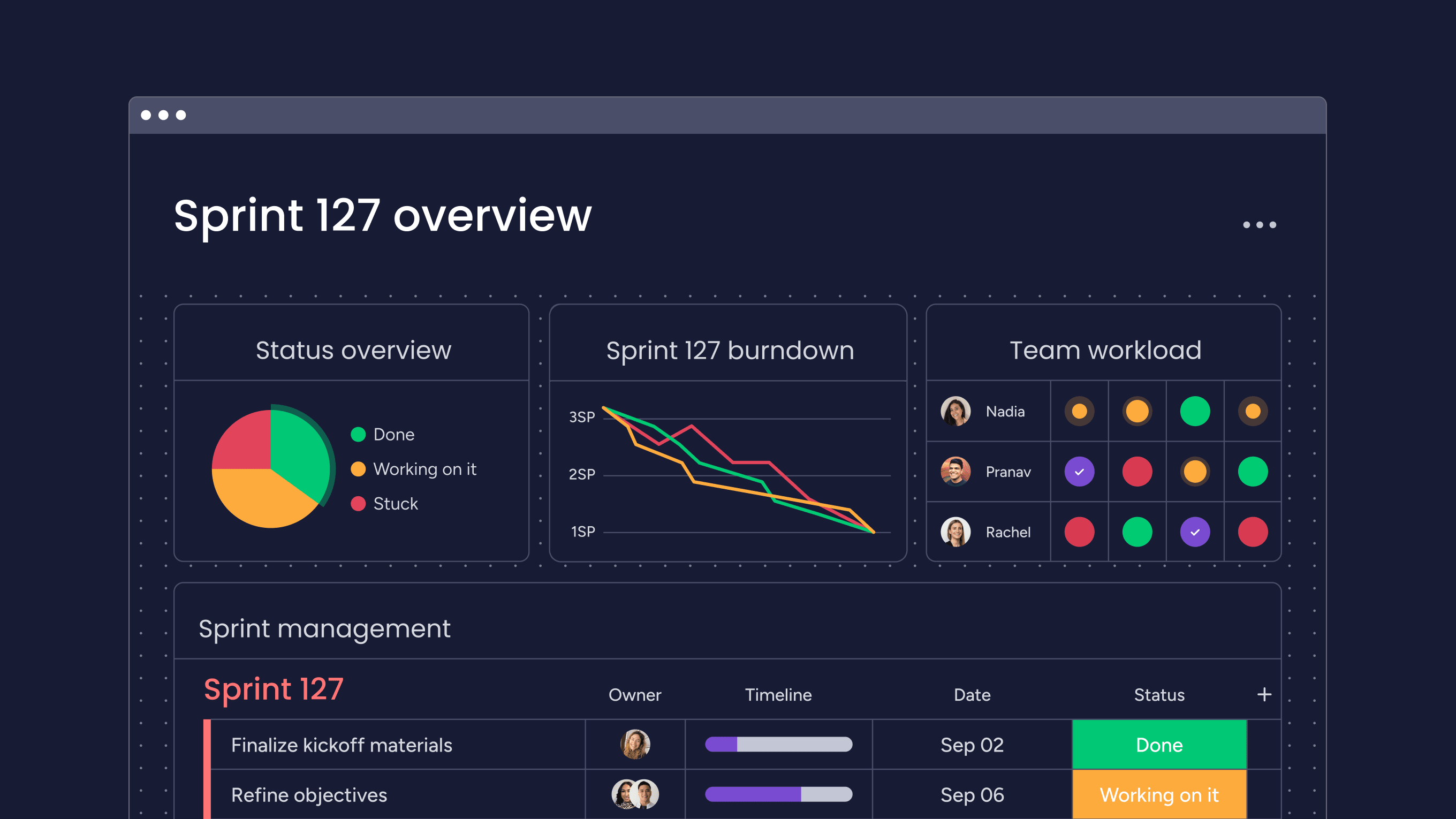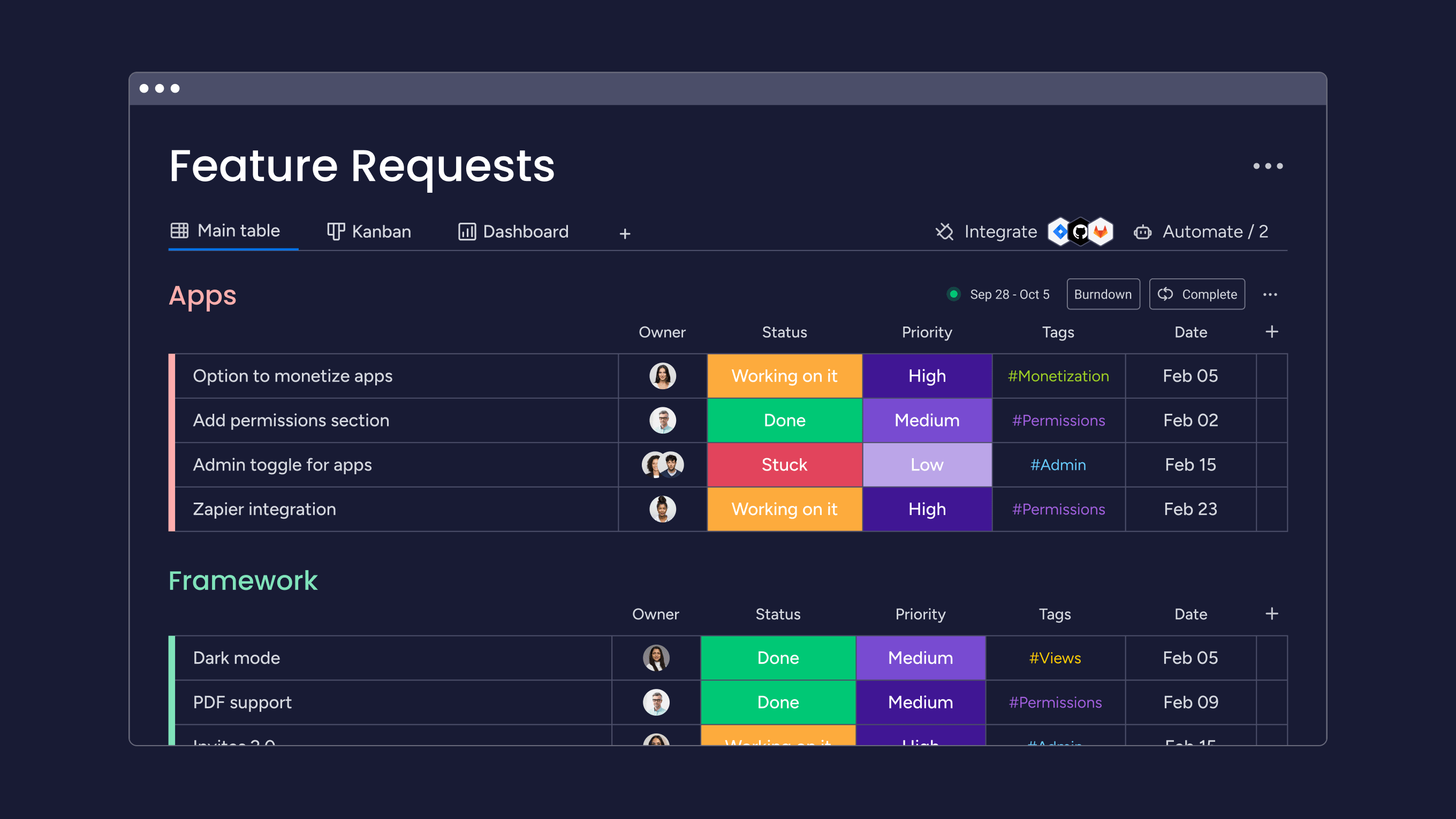Your product is only ever going to be as good as the development team you bring together to build it. But creating an effective software development team to create your product or software isn’t just about finding a group of gifted people and setting them to work.
To build a great development team, you need to start by understanding the fundamentals. What are the characteristics of a high-performing agile software development team? What are the challenges? What tools do they need to succeed?
This article should give you a solid foundation from which to start building your winning development team—and tell you a bit about monday dev, the product management platform that can help get your new team off to a flying start.
Try monday devWhat is a development team?

A development team is a group of people who work together to design, create, launch and implement a product, service, or solution.
A great development team will be effective at:
- Collaborating—team members work well together, communicate frequently, share knowledge, and support each other
- Iterating—the best development teams will approach their projects by creating an initial version or solution, and then working to continuously improve it in response to stakeholder and customer feedback
- Diverse thinking—a strong development team will bring together unique insights, training and perspectives, with everyone feeling like they have a voice in the software development process
- Customer-centricity—a high-performing development team will have a clear understanding of what customers want, as well as mechanisms for capturing and incorporating customer feedback in the development cycle
- Problem-solving—development teams need to solve complex problems and respond effectively to changing requirements and technical challenges
Types of development team
The most common types of development teams are:
Product development teams
Product development teams come together to build a product. They manage the entire product strategy, from initial ideation and vision to creating and implementing a product roadmap. Product development teams will include a diverse set of roles, typically including a product manager, UX or UI designers, and product marketers.
Software development teams
Software development teams are focused exclusively on building software products. They focus on coding, testing, and deploying software solutions. They will typically consist of software developers, quality assurance (QA) testers, and sometimes systems administrators or DevOps engineers.
Agile development teams
Many software developers use the Agile approach to manage their software projects. The Agile methodology is a flexible, iterative approach to software development that emphasizes adaptive planning, evolutionary development, early delivery, and continuous improvement.
Agile development teams work in short, time-boxed iterations called “sprints”, where a cross-functional “Scrum” team works collaboratively to deliver potentially shippable increments of the software product.
Product development team roles and responsibilities
The makeup of your product development team will depend on the product you’re building, of course. The most common roles you should think about incorporating into your software development team structure are:
Product owner/Product manager
The product owner, sometimes known as the product manager, is responsible for the overall success of the product. Their job is to:
- Create and communicate the product vision, strategy, and roadmapGather market needs, business objectives, and customer feedback to inform the product strategy
- Develop and manage the product roadmap, and decide on the order of priority for key features or customer requests (also known as user stories)
- Act as a liaison between stakeholders, development team, and other departments, and make sure that everyone remains on the same page and that communication flows smoothly between all parties
- Make product decisions, set product goals, and track key performance indicators (KPIs).
Software developer/engineer
If you’re building a software product, then you’ll need a team of software developers (or engineers) to:
- Write code to implement product features and functionality, within the required time frame, and then iterate on that code to improve performance and meet more user requirements
- Conduct code reviews, testing, and debugging to ensure high-quality software delivery
- Continuously improve coding practices, tools, and processes to enhance team productivity
UX/UI designer
The role of the user experience (UX) or user interface (UI) designer is to:
- Design intuitive, visually appealing products or user interfaces
- Gather user feedback through research, interviews, and usability testing
- Create wireframes, mockups, and prototypes to communicate design concepts to the rest of the team
- Collaborate with the product manager and developers to ensure designs align with user needs
Quality assurance (QA) engineer
Software product teams may also need a QA tester or engineer to:
- Write test plans, test cases, and automated test scripts to ensure product quality
- Collaborate with developers to troubleshoot and resolve bugs on time
Some teams may decide that QA testing can be handled by the existing product team, rather than requiring an additional full-time team member—especially if you’re using automated testing software or outsourcing manual testing.
Business analyst/Data analyst
If you’re handling a lot of data in your development process, you may also need a business analyst or data analyst to:
- Analyze product use data, metrics, and user feedback to gain insights into user behavior and needs
- Monitor product performance, and measure and report on key metrics
- Work with product managers and other team members to make data-driven decisions and prioritize features
- Identify opportunities for product optimization based on data analysis
4 tips for building a strong development team
Whether you’re hiring a new team or forming a new product development team from existing employees, there are a few best practices to bear in mind:
1. Hire the right team members
You need to consider both the overall make-up of the team, and the characteristics you need for each individual. In addition to technical skills and background, look for:
- Values alignment—Jens-Fabian Goetzmann, the Head of Product at RevenueCat, recommends that you reduce your own bias by asking yourself, “Does this person subscribe to our (company / team) values?”
- Diversity—Research shows that diverse teams tend to perform better. Consider diversity of skills, background, and experience, as well as other demographic factors like gender and race.
- People skills—Annie Dunham, the Former VP of Product Management at ProductPlan, recommends hiring passionate, committed team players who will help the whole product team do their best work.
2. Encourage constant learning
Product teams need to be able to adapt quickly to changing market needs and customer requirements.
High-performing product teams need a culture of continuous improvement.
To create an atmosphere of constant learning:
- Invest in ongoing learning opportunities so team members can increase their technical expertise, knowledge, and skills as needed.
- Encourage knowledge sharing and cross-training among team members to foster collaborative, on-the-job training.
3. Set clear objectives

Start by creating and communicating a clear vision for the overall product, as well as how the product aligns with the rest of your company’s strategy.
Then, break down the general product vision into objectives—you can either use SMART goal setting or Agile methodology to create a short list of key objectives for your product team. Next, establish priorities for each objective, before segmenting your objectives into actionable tasks.
These objectives will then form the basis of your product roadmap.
4. Foster a collaborative team culture
The best product development teams work closely together and support each other’s progress. Each team member feels valued and encouraged to share their ideas. To promote a more collaborative team culture:
- Encourage regular team meetings, brainstorming sessions, and collaborative decision-making processes to build a sense of ownership and commitment to the common goal.
- Provide tools that make regular communication easy.
- Work from a single source of truth, such as a product roadmap hosted in a shared, collaborative workspace like monday dev.
Empower your development team with monday dev

Product development teams need great tools to truly thrive. We built monday dev to make product management far easier, and keep high-performing development teams on the same page during the intense process of building and launching new products. monday dev can help your new development team with:
- Sprint management that lets your development team effortlessly oversee their sprints from initiation to completion, while easily tracking progress all in one centralized platform.
- Workflow management features so you can streamline the entire development workflow, from roadmap planning, to sprint execution, to backlog management, to bug tracking and retrospective elements, all within a visual, easy-to-use interface.
- Deadline and Gantt tracking to give you a comprehensive view of timelines, so you can monitor your performance against KPIs and milestones.
- Communication and updates, so you can skip unnecessary emails and meetings by enabling direct feedback on relevant items without the need to switch between multiple tools.
- 150+ pre-built, customizable automations, to make your team more efficient by automating repetitive tasks.
monday dev can revolutionize your development team’s productivity and efficiency, ensuring smoother workflows and successful product launches.
FAQs
What is the role of a development team?
A development team works together to design, create, launch, and implement a product, service, or solution. They ensure that the project requirements are met through efficient software development process management. Their roles include coding, designing, testing, and iterating on product features to meet user and stakeholder needs.
What does a good development team look like?
A good development team is collaborative, communicative, and customer-focused. They possess a diversity of skills and perspectives, can iterate quickly based on feedback, and are effective problem-solvers. High-performing teams maintain clear objectives, continuously learn, and work well together towards their common goal.
What are the 5 stages of developing a team?
The 5 stages of developing a team include:
Forming: setting the foundation by assembling team members and defining roles.
Storming: addressing challenges and conflicts as the team works through differences.
Norming: developing team norms and refining processes for smoother collaboration.
Performing: achieving high performance and productivity through effective teamwork.
Adjourning: completing the project and transitioning or disbanding the team.
 Get started
Get started 
